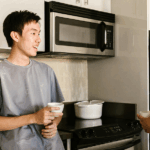Chris Walker reflects on the Moderator’s “Living Waters” pilgrimage from Parramatta to North Head.
About 15 of us gathered for breakfast at Pancakes on the Rocks at Northmead, from where we started our June 13 “Living Waters” pilgrimage led by the Moderator, the Rev. Niall Reid.
We enjoyed forming into a group of pilgrims, carrying the “Woman at the Well” icon to reflect upon, and setting out after some opening comments and guidance from Niall.
We proceeded along Toongabbie Creek to the point where it meets the Darling Mills Creek, which is the start of the Parramatta River.
Niall led us in a reflection there. I had not previously been to this spot, which has Cumberland Hospital on one side and light industry on the other.
No doubt in past centuries Aboriginal people, the Darug people, would have been familiar with the location, which may well have been significant for them.
We then made our way to Parramatta Park, stopping at another point, notable not just for water pouring over the weir but also for the large bat colony in the trees above.
It started raining, which was inconvenient, but we were on a pilgrimage about “living waters” so perhaps it was appropriate to experience the source of water from the clouds above.
We continued on walking past old Government House and through the streets of Parramatta, Australia’s second European settlement, along the banks of the river to the ferry terminal. It was low tide so we had to catch a bus to the next terminal in order to ride the ferry.
Source of life
It was comfortable inside as there was wind and some rain outside. We humans cannot cope with too much from the natural world.
We noted the plants on the riverbank and the different types of houses and home units built near the river. There were many moored boats and some water craft heading along the river.
Rivers in many places are the main way people travel to villages and towns. Water is not only a source of life for plants, animals and people. It is also a way of getting to distant places that would be difficult to reach by land.
At Circular Quay, the site of the first European settlement, there was a source of much needed fresh water known as the Tank Stream. We walked to Bennelong Point and, after trying to find a place out of the wind, settled on the steps of the Opera House to have our lunch.
People’s hopes on coming to this land were no doubt devastated as they or loved ones died after making the long voyage across the ocean to Australia.
One policeman came up to us and we thought he might want to move us on. When asked if we were a tour group, Niall replied that we were a group of pilgrims. He left us with a smile.
After lunch I went for a walk in the Botanic Gardens nearby. From there you could look up from the many trees and plants to see the impressive buildings of the city. I walked around to where I could look across the waters of Sydney harbour to see the Opera House and Sydney Harbour Bridge.
Recently I climbed it with my wife and we had a great view of Sydney and its harbour. I also reflected on the use of the word “Eternity” on the bridge on New Year’s Eve 2000.
The city needs God’s larger perspective, spirituality, if it is not to be a grasping city that fails to care for vulnerable and needy people.
Hospitality
We then went back to Circular Quay to the wharf where we caught the ferry to Manly.
A couple of extra people from Gosford had joined us.
The ferry ride to Manly had us moving from side-to-side with spray rising up outside as the ferry hit the swells as we crossed the heads. Then it settled down again as we headed towards the calmer waters of Manly.
From the wharf we walked up the long hill to St Patrick’s. Once a Catholic seminary, it is now a centre to train people in hospitality. This is perhaps an appropriate use given the importance of hospitality in Christian tradition but it does represent a secular rather than spiritual practice.
We paused and had a time of silence to reflect on our life’s changes and journey.
Then we continued on to the military area, thankfully now no longer an exclusion zone. For me it highlighted the privileged position of the military and the importance given to the military in our society.
As a pilgrim, I reflected that for the first three centuries of its existence the Church was pacifist. It was only with the conversion of the Emperor Constantine that a huge change took place and Christians came to regard military service as a duty and the “Just War” theory was developed.
Having recently returned from Jamaica from a World Council of Churches conference on peace, I affirmed its intention to change the discussion from just war to just peace — peace with justice as the peace or “shalom” the Bible speaks about.
We made our way along a metal boardwalk through the trees to a small cemetery, which had the graves of people who died from smallpox, bubonic plague and the influenza epidemic following World War I that claimed millions of lives around the world.
People’s hopes on coming to this land were no doubt devastated as they or loved ones died after making the long voyage across the ocean to Australia.
We finished at a look out point at North Head, where we could see down the harbour to the city of Sydney looking magnificent in the distance.
In the foreground the bush was probably similar to what Aboriginal people had known for millennia. In the background was the major city of Australia, representing what modern or postmodern civilisation is like, with its transformation of raw materials into buildings, means of transport and technology.
Yet it is not a godless place.
I reflected that the last book in the Bible does not talk of a new Eden but a new Jerusalem, a city with God in its midst.
That is what Sydney requires, a spirituality to sustain it. The Church, including our Uniting Church, is not an optional extra. We have a role to play in helping our city and nation to be the kind of community that practises justice and compassion.
We are to point people to Jesus, who wept over the city of Jerusalem because it failed to recognise the things that make for peace.
We focus on Jesus Christ because he is the visible image of the invisible God who created all things and would lead them to their true fulfilment in God’s reign of love, justice and peace.
It had been a long day with many good conversations with people along the way. Now we headed back to rejoin the ferry and make our way home, progressively leaving people as we did so.
The Basis of Union says, “The Church is a pilgrim people, always on the way towards a promised goal.” The city we seek is not here but one to come.
Nevertheless we are to seek the welfare of the city, knowing that is what Christ wants. God sustains us by Word and Sacraments and we have practices such as pilgrimages to remind us of what is really important.
Finally, all comes from God who does provide the living water of the Spirit that we may persevere and not lose the way.
Chris Walker is the Uniting Church’s National Consultant, Theology and Discipleship.













1 thought on “On the way to what matters”
Hi Chris
Great pilgrimage! I’ve written a book about mine – a 3 week journey along the Yarra River in melbourne – it’s called the Comfort of Water – you might find it interesting as it explores many similar themes.
all the best to you fellow pilgrim
Maya